Do you have a question about the Hitachi RAS-20FSG and is the answer not in the manual?
Basic checks, wiring, displays, and emergency operations for system issues.
Explains the setting of dip switches and rotary switches on the indoor unit PCB for proper operation.
Details how to check the outdoor unit's 7-segment LED display for simple troubleshooting.
Provides procedures for emergency operation when the inverter compressor fails, allowing basic functionality.
Guides on troubleshooting power supply failures, including checking fuses and LCD indications.
Lists phenomena and causes for device abnormalities when normal operation is not available.
Details alarm codes, check modes, and device abnormalities for systematic fault diagnosis.
A comprehensive table listing alarm codes, their content, and leading causes for quick diagnosis.
Step-by-step guide for diagnosing issues based on specific alarm codes indicated on the remote control.
Outlines self-checking methods for PCBs, remote controls, and other major components.
Outlines the procedure to test PCBs using the remote control switch's check mode.
Details the method for self-checking the remote control switch's LCD and transmission circuit.
Explains how to perform test runs using remote controls or the outdoor unit for system verification.
Explains how to activate and perform test runs using the remote control switch for system verification.
Procedures for disassembling and removing components from the outdoor unit.
Step-by-step instructions for removing the air intake grille from various outdoor unit models.
Guides on safely removing the front service panel from different outdoor unit models.
Procedures for detaching the propeller fans from the motor shafts of outdoor units.
Detailed steps for removing the compressor, including refrigerant collection and terminal checks.
Outlines the process for removing pressure sensors and switches from outdoor units.
Instructions for removing the reversing valve by disconnecting piping and electrical connections.
Guides on removing PCBs, transistor modules, and other electrical parts from the outdoor unit.
Step-by-step guide for removing components from specific indoor unit models.
Steps for removing the control PCB from the electrical box of In-the-Ceiling indoor units.
Detailed instructions for removing the fan motor assembly from In-the-Ceiling indoor units.
Procedures for draining and removing the drain pan from In-the-Ceiling indoor units.
Detailed instructions for disassembling and removing parts from 4-way cassette indoor units.
Guides on removing the fan runner, fan motor, and associated components from 4-way cassette units.
Steps for safely removing the PCB from the electrical box of 4-way cassette indoor units.
Procedures for removing components from 2-way cassette indoor units.
Instructions for removing the PCB from the electrical box of 2-way cassette indoor units.
Procedures for draining and removing the drain pan from 2-way cassette indoor units.
Step-by-step guide for disassembling and removing parts from wall-mounted indoor units.
Step-by-step guide to safely remove the front panel of wall-type indoor units.
Detailed instructions for removing the indoor unit's PCB, including connector and dip switch handling.
Details the structure and components of the total heat exchanger unit.
Guidelines for cleaning the air filter using a vacuum cleaner or water.
Instructions for cleaning the total heat exchanger element, emphasizing proper methods and precautions.
Instructions and tools needed for cleaning indoor unit heat exchangers for various types.
Detailed procedure for cleaning the heat exchanger of in-the-ceiling indoor units.
Step-by-step guide for cleaning the heat exchanger of 4-way cassette indoor units.
Instructions for cleaning the heat exchanger of wall-type indoor units, including protection measures.
Procedure for safely collecting refrigerant when replacing an indoor unit.
Details inverter specifications, protection functions, and overload controls for system operation.
Details inverter specifications, including voltage, current, and frequency ranges.
Explains inverter protective functions like voltage, current, and temperature monitoring.
Explains the concept, features, and specifications of the AC Chopper control for fan motors.
Covers the reliable mechanism, compression principle, and structure of scroll compressors.
Explains the fundamental principle of compression used by scroll compressors.
Details the position and characteristics of thermistors used in indoor and outdoor units.
Details the position and resistance characteristics of indoor unit thermistors.
Details the position and resistance characteristics of outdoor unit thermistors.
Provides specifications and wiring diagrams for electronic expansion valves in outdoor and indoor units.
Provides specifications, wiring diagrams, and activation modes for outdoor electronic expansion valves.
Explains the device that prevents compressor damage from high discharge pressure.
Describes the function and specifications of capacitors used for AC to DC current conversion in the inverter.
Describes optional functions for indoor units like remote control and automatic power supply.
Explains system start/stop control using external signals via remote control or BMS.
Details how to use a field-supplied room thermostat for temperature control, including wiring and settings.
Describes how to change operation modes (cooling/heating) using external contact signals.
Covers input/output settings, remote control functions, and optional settings for specific indoor units.
Covers procedures for setting input/output signals and selecting indoor units via PCB connectors.
Explains ON/OFF control using pulse or level signals from a remote place.
Explains external signal inputs/outputs, demand control, and operation mode settings for outdoor units.
Details demand control limiting compressor frequency based on input terminals.
Describes changing defrosting conditions using dip switch settings for different areas.
Details the name of parts, simultaneous operation, and optional function settings for remote controls.
Guides on setting optional functions via remote control dip switches and menus.
Details optional functions like filter cleaning, heating calibration, and compressor operation limits.
Explains installation, identification, simultaneous operation, and optional functions for wireless remote controls.
Instructions for operating the unit in emergency mode when the remote control is unavailable.
Analyzes compressor burnout from insufficient refrigerant charge, including causes and countermeasures.
Addresses cooling performance issues related to long piping lengths and necessary dip switch adjustments.
Provides critical considerations for system design and installation of FXG/FX3 series units.
Highlights safety measures and calculations for permissible refrigerant concentrations due to leakage.
Outlines routine inspection and maintenance procedures for indoor and outdoor units.
Basic checks, wiring, displays, and emergency operations for system issues.
Explains the setting of dip switches and rotary switches on the indoor unit PCB for proper operation.
Details how to check the outdoor unit's 7-segment LED display for simple troubleshooting.
Provides procedures for emergency operation when the inverter compressor fails, allowing basic functionality.
Guides on troubleshooting power supply failures, including checking fuses and LCD indications.
Lists phenomena and causes for device abnormalities when normal operation is not available.
Details alarm codes, check modes, and device abnormalities for systematic fault diagnosis.
A comprehensive table listing alarm codes, their content, and leading causes for quick diagnosis.
Step-by-step guide for diagnosing issues based on specific alarm codes indicated on the remote control.
Outlines self-checking methods for PCBs, remote controls, and other major components.
Outlines the procedure to test PCBs using the remote control switch's check mode.
Details the method for self-checking the remote control switch's LCD and transmission circuit.
Explains how to perform test runs using remote controls or the outdoor unit for system verification.
Explains how to activate and perform test runs using the remote control switch for system verification.
Procedures for disassembling and removing components from the outdoor unit.
Step-by-step instructions for removing the air intake grille from various outdoor unit models.
Guides on safely removing the front service panel from different outdoor unit models.
Procedures for detaching the propeller fans from the motor shafts of outdoor units.
Detailed steps for removing the compressor, including refrigerant collection and terminal checks.
Outlines the process for removing pressure sensors and switches from outdoor units.
Instructions for removing the reversing valve by disconnecting piping and electrical connections.
Guides on removing PCBs, transistor modules, and other electrical parts from the outdoor unit.
Step-by-step guide for removing components from specific indoor unit models.
Steps for removing the control PCB from the electrical box of In-the-Ceiling indoor units.
Detailed instructions for removing the fan motor assembly from In-the-Ceiling indoor units.
Procedures for draining and removing the drain pan from In-the-Ceiling indoor units.
Detailed instructions for disassembling and removing parts from 4-way cassette indoor units.
Guides on removing the fan runner, fan motor, and associated components from 4-way cassette units.
Steps for safely removing the PCB from the electrical box of 4-way cassette indoor units.
Procedures for removing components from 2-way cassette indoor units.
Instructions for removing the PCB from the electrical box of 2-way cassette indoor units.
Procedures for draining and removing the drain pan from 2-way cassette indoor units.
Step-by-step guide for disassembling and removing parts from wall-mounted indoor units.
Step-by-step guide to safely remove the front panel of wall-type indoor units.
Detailed instructions for removing the indoor unit's PCB, including connector and dip switch handling.
Details the structure and components of the total heat exchanger unit.
Guidelines for cleaning the air filter using a vacuum cleaner or water.
Instructions for cleaning the total heat exchanger element, emphasizing proper methods and precautions.
Instructions and tools needed for cleaning indoor unit heat exchangers for various types.
Detailed procedure for cleaning the heat exchanger of in-the-ceiling indoor units.
Step-by-step guide for cleaning the heat exchanger of 4-way cassette indoor units.
Instructions for cleaning the heat exchanger of wall-type indoor units, including protection measures.
Procedure for safely collecting refrigerant when replacing an indoor unit.
Details inverter specifications, protection functions, and overload controls for system operation.
Details inverter specifications, including voltage, current, and frequency ranges.
Explains inverter protective functions like voltage, current, and temperature monitoring.
Explains the concept, features, and specifications of the AC Chopper control for fan motors.
Covers the reliable mechanism, compression principle, and structure of scroll compressors.
Explains the fundamental principle of compression used by scroll compressors.
Details the position and characteristics of thermistors used in indoor and outdoor units.
Details the position and resistance characteristics of indoor unit thermistors.
Details the position and resistance characteristics of outdoor unit thermistors.
Provides specifications and wiring diagrams for electronic expansion valves in outdoor and indoor units.
Provides specifications, wiring diagrams, and activation modes for outdoor electronic expansion valves.
Explains the device that prevents compressor damage from high discharge pressure.
Describes the function and specifications of capacitors used for AC to DC current conversion in the inverter.
Describes optional functions for indoor units like remote control and automatic power supply.
Explains system start/stop control using external signals via remote control or BMS.
Details how to use a field-supplied room thermostat for temperature control, including wiring and settings.
Describes how to change operation modes (cooling/heating) using external contact signals.
Covers input/output settings, remote control functions, and optional settings for specific indoor units.
Covers procedures for setting input/output signals and selecting indoor units via PCB connectors.
Explains ON/OFF control using pulse or level signals from a remote place.
Explains external signal inputs/outputs, demand control, and operation mode settings for outdoor units.
Details demand control limiting compressor frequency based on input terminals.
Describes changing defrosting conditions using dip switch settings for different areas.
Details the name of parts, simultaneous operation, and optional function settings for remote controls.
Guides on setting optional functions via remote control dip switches and menus.
Details optional functions like filter cleaning, heating calibration, and compressor operation limits.
Explains installation, identification, simultaneous operation, and optional functions for wireless remote controls.
Instructions for operating the unit in emergency mode when the remote control is unavailable.
Analyzes compressor burnout from insufficient refrigerant charge, including causes and countermeasures.
Addresses cooling performance issues related to long piping lengths and necessary dip switch adjustments.
Provides critical considerations for system design and installation of FXG/FX3 series units.
Highlights safety measures and calculations for permissible refrigerant concentrations due to leakage.
Outlines routine inspection and maintenance procedures for indoor and outdoor units.
| Brand | Hitachi |
|---|---|
| Model | RAS-20FSG |
| Category | Air Conditioner |
| Language | English |



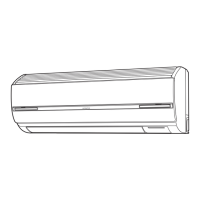


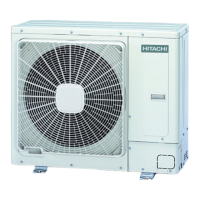
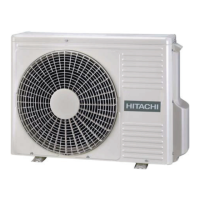
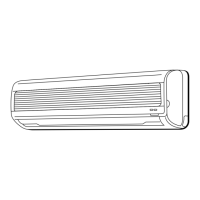
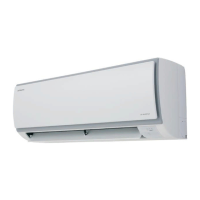


